SUMMARY
This is AI generated summarization, which may have errors. For context, always refer to the full article.
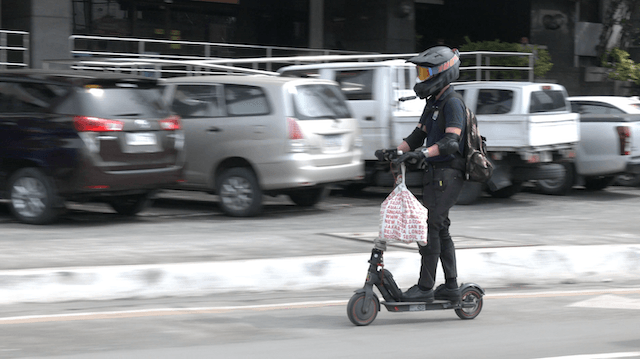
MANILA, Philippines – Since the price of gas started spiking, 32-year-old training manager Russell Co noticed renewed interest among his friends in electric kick scooters, his preferred mode of transportation to work.

For the same reason, 24-year-old law student Miguel Quijano now turns to his electric kick scooter even for farther destinations.
Tim Vargas, co-founder of Electric Kick Scooter Philippines reported a 15% rise in scooter sales from 2021 and fresh interest in his group, which now has 23,000 members and counting.
“I can no longer imagine myself taking a car unless I’m with my family,” Vargas told Rappler.
“That’s our hard rule as personal mobility advocates. If you’re alone or just bringing stuff you can carry, no compromise, you should ride an e-kickscooter,” he added.
The personal mobility revolution in Metro Manila’s streets may have started during the COVID-19 pandemic. But it’s being spurred on by frequent surges in oil prices that are making car use less and less ideal.
Even non-drivers are feeling the strain, as any Grab user will tell you after mulling the expensive fares displayed in their app.
Electric kick scooters or stand-up scooters are fast becoming that in-between option for people who don’t want to ride cars or motorcycles, but also don’t have the energy for the physical exertion of biking.
Savings on gas, parking
E-kickscooters come in a variety of price points, within the budget of a college student or a business executive.
Entry-level models can cost anywhere from under P10,000 to P20,000. High-end units which have greater battery capacity and speed, can go for P30,000 or reach more than a hundred thousand pesos.
There is also a thriving market for second-hand kick scooters. Co’s is a secondhand Xiaomi model he bought for P15,000. He’s been using it for close to four years.
If the kick scooter is ridden often enough, Co and Vargas said the fuel savings alone justify the purchase.
Vargas claimed he’s saved P276,000 over three years, using his e-kickscooter instead of a car to travel 18,000 kilometers.
Co said he is able to save the equivalent of a full tank of gas every month.
The electricity cost is negligible in comparison. Vargas said charging one of his kick scooters costs him P80 in his monthly electricity bill. Because his batteries are high-capacity, he charges only every 10 days.
The charging technology is as simple as it gets – just a power brick the size of those for laptops, connected to a wall power outlet.
Though electricity rates in the Philippines, and in particular Metro Manila, are the highest in Southeast Asia, they don’t fluctuate as radically as oil prices, said Vargas.
Considering savings on parking fees and the reduction in travel time, choosing their e-kickscooters is a no-brainer for Vargas and Co.
But the scooters have their limits, too. They are difficult to ride during heavy rain when flooded streets can damage their components. Earnings from scooter repairs typically shoot up in the rainy months of July and August, said Vargas. While safety is a major concern, the MMDA recorded only two accidents involving e-kickscooters – out of 64 reported incidents involving electric vehicles in general – from January to May.
What is micromobility?
Micromobility refers to a range of light-weight vehicles designed for individual use. They include bicycles, skateboards, scooters, kick scooters, and their electric counterparts.
It’s a growing global trend.
In a 2021 micromobility report, market research firm McKinsey and Company saw large global acceptance for micromobility options. Some 70% of respondents globally said they preferred micromobility options to public transportation or cars.
The biggest chunk, 40%, preferred either traditional or electric bicycles. But 12% said they would use an electric kick scooter.

in a 2021 report, the firm said the future of transportation is sustainable mobility and electric vehicles.
“Consumer behavior and awareness are changing as more people accept alternative and sustainable mobility modes. Inner city trips with shared bicycles and e-scooters have risen 60% year-over-year,” said the report.
Abroad, there are already apps for sharing electric kick scooters, like Lime and Bolt.
In the Philippines, electric kick scooter sales are rising. Local distributors earned P320 million in 2021, a huge leap from just P600,000 in 2016, said Vargas.
Vargas himself is a local distributor of high-end e-kickscooter brand Dualtron. He calls himself a “capitalist advocate” for personal mobility.
Despite improvements in public transportation like more train carriages and expanded train networks, Vargas said long lines for trains, jeepneys, and buses can be a turn-off and convince more people to use micromobility options instead.
While some 60% of e-kickscooter users in the Philippines are millennials, or those aged 24 to 44, Vargas said the future of e-kickscooters is GenZ.
“Because they are growing up in this environment. When our age group was growing up, bike lanes weren’t as common. Now, they are. So the GenZ are slowly realizing they have other options,” Vargas said in Filipino.
The right environment
The mass uptake of e-kickscooters and other more sustainable modes of transportation will depend on local conditions, said the McKinsey and Company report.
The most important factor is public infrastructure that encourages these options.
Co, describing his Monday ride to work, said bike lanes in Metro Manila still don’t get the respect they deserve from other motorists.
“It was relatively good today, there weren’t any obstructions. There was a close call with the taxi, but that’s pretty much a daily occurrence. Before, it was tricycles that turn without looking. Now that you’re on the main road, it’s bigger vehicles,” he said.
Many bike lanes aren’t maintained well, making for bumpy rides that could be safety hazards. After falling down from his kick scooter a few times, Co invested in a sturdier helmet, knee pads, and elbow pads.
“For me, it’s the puddles, that’s why I avoid them because you can’t really get them (e-kickscooter) wet and sometimes the puddles hide the bigger holes,” said Co.
Most of the government investment so far has been on bike lanes in major urban centers like Metro Manila, Metro Cebu, and Metro Davao. Bike lanes are used by e-kickscooter riders, aside from cyclists.

In 2020, the government allocated P1.3 billion for bike lanes in these areas as part of its pandemic recovery plan. The funds were made available through the Bayanihan to Recover As One Act.
By April 2022, the government was able to complete 563 kilometers of bike lanes in Metro Manila, Metro Cebu, and Metro Davao.
These bike lanes feature physical separators like bollards (short, sturdy posts acting as a perimeter), solar studs to mark the lanes at night, pavement markings, and bike racks placed in strategic locations.
Vargas estimated that “95%” of EDSA, Metro Manila’s central thoroughfare, has bike lanes but these lanes are often extremely narrow or else full of holes or obstructions.
Thanks to efforts of government, academe, and some local governments, more charging stations for e-vehicles and e-kickscooters have been put up.
This year, three charging stations were launched in Quezon City. In June, the Metropolitan Manila Development Authority or MMDA opened a station in their headquarters in Pasig. The MMDA plans to open another one in Makati and in their office along EDSA and Orense Street.
Electric vehicle law
The future of electronic kick scooters looks even brighter as the Electric Vehicle Industry Development Act (EVIDA) lapsed into law in April.
The law orders local governments and the public works and highways department to construct segregated lanes for light electric vehicles like e-kickscooters in all major local and national roads, and lanes that can be integrated with bike lanes.
EVIDA promises fiscal incentives, possibly tax exemptions for manufacturers and importers of electric vehicles, including light electric vehicles. Slashing tax duties are intended to make electric vehicles more affordable and able to compete with prices of traditional vehicles.
The Bureau of Customs has also been ordered to expedite the processing of parts and components of electric vehicles being imported by manufacturers and importers.
Buildings constructed after the law became effective now need to dedicate a certain number of parking spaces for electric vehicles, including light electric vehicles.
The law, however, still lacks approved Implementing Rules and Regulations (IRR), supposed to be completed 120 days after the measure’s effectivity.
Part of the motivation to encourage electric vehicles is the government’s goal to reduce carbon emissions from vehicles on the road, which account for 88% of emissions from Philippine transportation, according to a 2010 government inventory of greenhouse gas emissions.
The transport sector is the country’s second biggest source of emissions, contributing 31.3%. But critics of electric vehicles point to how they still rely on electricity, which, in the Philippines, still mostly comes from fossil fuels. The energy sector is the country’s top source of emissions, contributing 42%. To give credence to the EV sector’s “green” and “sustainable” image, some EV charging stations are powered by solar panels.
For Vargas, the recognition of e-kickscooters and its riders are a hardwon achievement of his group’s early years of looking like “fools” riding a “kid’s toy” in the streets of Bonifacio Global City.
But they know there’s still a long way to go to a future where fossil-fuel cars are people’s last resort instead of their go-to.
One way the kickscooter community is trying to get there is promoting discipline and obedience to rules among its members, a way of gaining respect among the greater commuting public.
“We win one lane at a time. We share it,” Vargas said.
“Then eventually, when we wean more people from their cars and slowly bring them to a personal mobility device, then there will be less cars on the road, there will be more lanes for everyone.” – Rappler.com
Add a comment
How does this make you feel?

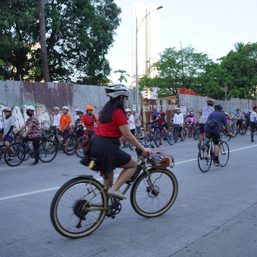
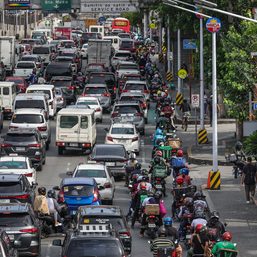
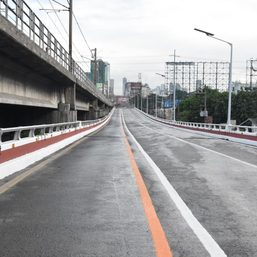



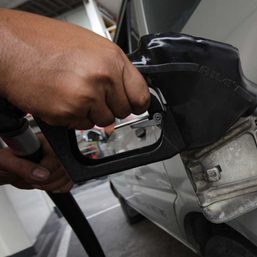
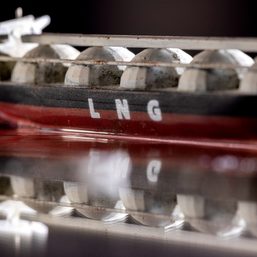

There are no comments yet. Add your comment to start the conversation.